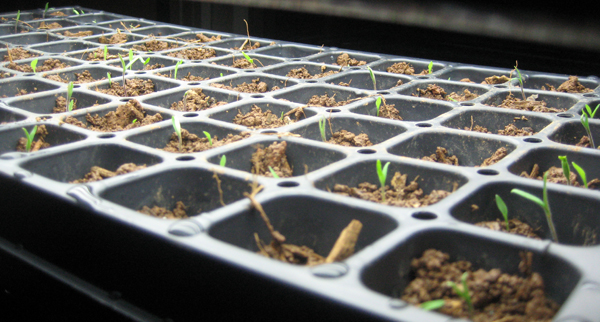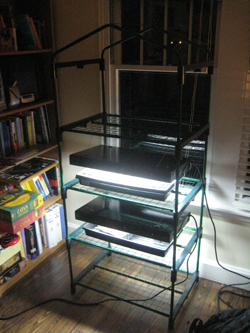One way to go about gardening is to buy trays of plants, bags of soil and fertilizer, and bottles of pesticides. A steady stream of some bright, near fluorescent blue liquid guarantees monstrous tomatoes, Stepford squash and dazzling flowers. Practically anyone can purchase a green thumb, year after year. But that blue wonder also guarantees fertilizer runoff and water contamination.
As if the environmental effects of commercial fertilizers weren’t enough, their dubious source also makes a strong case for avoidance. Just take a look at the back of any of the boldly marketed miracle products—all owe their existence to dead dinosaurs, a feat which is relatively modern. In 1909 the Haber-Bosch process was perfected in Germany, which makes atmospheric nitrogen more readily available. The primary source for the chemical reaction is methane from natural gas. Ecologist David Wolfe wrote in his book, Tales from the Underground: A Natural History of Subterranean Life: estimates that nearly a third of the world’s population is sustained by this method. What a terrifying status quo. The source of our unprecedented level of low cost agricultural output is based on the same non-renewable raw material that we use for energy and transportation.
It is a vicious cycle—the leading cause of climate change is perceived as an agricultural necessity, as droughts and shifting weather patterns push traditional means of growing even further out of sight. Consider the 2008 food crisis, which caused riots in dozens of countries across the globe. The World Bank at the time estimated that over 100 million people would be pushed into poverty by rising food prices. Climate change, biofuels and increased demand from India and China were cited among the causes. Now imagine that a third of the world’s food supply is threatened, as the effects of peak oil continue to make fossil fuels increasingly scarce. You get the idea. Growing your own food organically, and bypassing the petrochemical industry, is slowly being recognized as a powerful means of subverting the industrial model.
There is of course another, more ancient way than the packaged one. Depending on the last date of frost and the expected maturation time in your area, plant varieties can be started from seed indoors. The Farmer’s Almanac puts this date at April 6 for Middle Tennessee. Keep in mind that a surprise frost can still occur for a few weeks after the last frost date, so it is a good idea to have some old sheets and bricks handy for covering. I feel obliged to confess, this is my first year of trying to grow everything from seed. I have usually relied on a mix of seeds and purchased trays, although last year the majority was from seeds. The picture here shows my current setup. The indoor greenhouse was only $25 at Home Depot, while the same unit sold for $40 at Lowe’s, as of February. The grow lights that I am using are fluorescent T5s, which use 84 watts as a system. At 16 hours of on time per day, the total monthly cost for the two lighted growing shelves in the picture is about $3.63.
Instead of buying a bag of potting soil, I went out to my garden and filled a 5 gallon bucket. A first for me this year was pasteurizing the soil, which kills any dormant weed seeds and fungus spores. To pasteurize soil, simply put soil on a baking tray (max 4 inches thick), and heat to an internal temperature of 180 °F for 30 minutes. There are more extensive ways to create your own potting soil. The ideal soil, according to Rodale’s Illustrated Encyclopedia of Organic Gardening, is:
• both moisture retentive and well aerated
• contains an appropriate quantity of nutrients
• allows a vigorous root system to develop
• is uniform in consistency and predictable in behavior
• is free from pathogens
I have been composting for years, and hope that the garden soil I have used will work for seedlings. If not, it is always possible to augment the soil with a natural fertilizer that is not derived from fossil fuels. My end goal is to optimize the growing medium so as not to have to buy any type of fertilizer. Even among the organic fertilizers, labels still have to be read. I personally try to avoid the ones that include feather and bone meal. Using the byproducts of tortured animals to grow an organic garden seems to miss the point. One last issue not to be overlooked in any discussion of organic gardening is peat. Peat is the base material for the soilless growing mediums that have become commercially popular over the past few decades. Peat is essentially decayed plant matter, and comes from bogs. Extraction harms fragile ecosystems, and exposes massive amounts of methane, a greenhouse gas that has a global warming potential (GWP) 21 times that of carbon dioxide. If you are interested in using a soilless product, there are a number of “peat-free” products available.
Good luck with your 2013 garden, and the Pulse would love some pictures!















